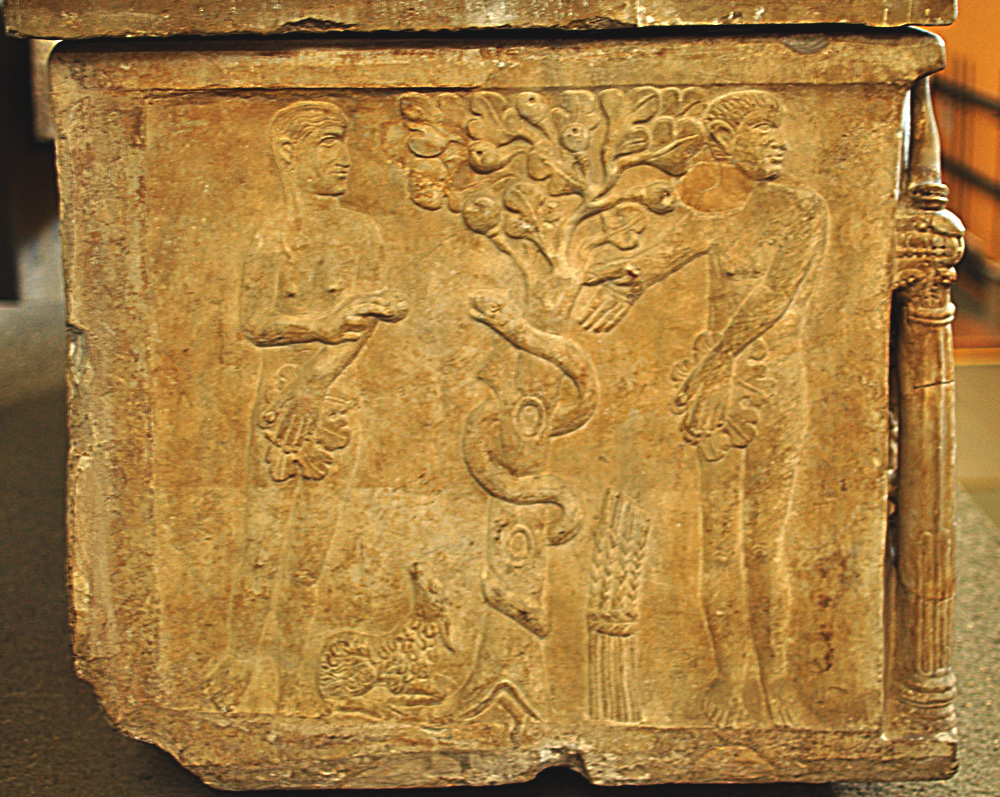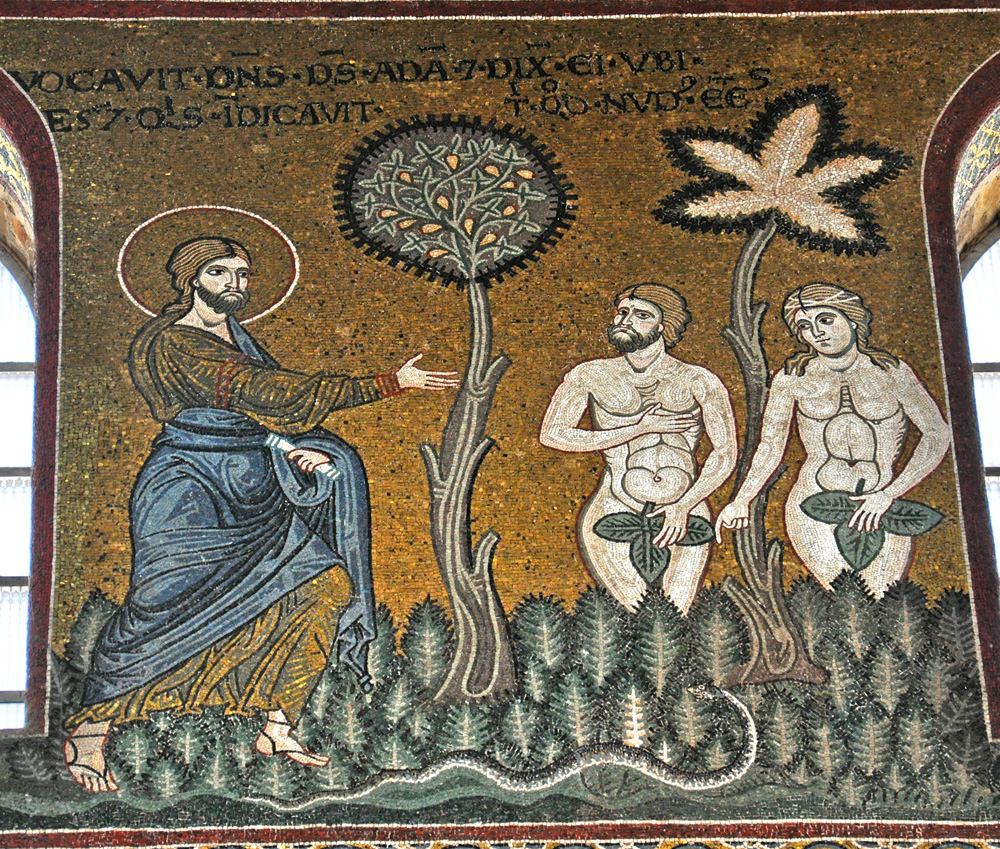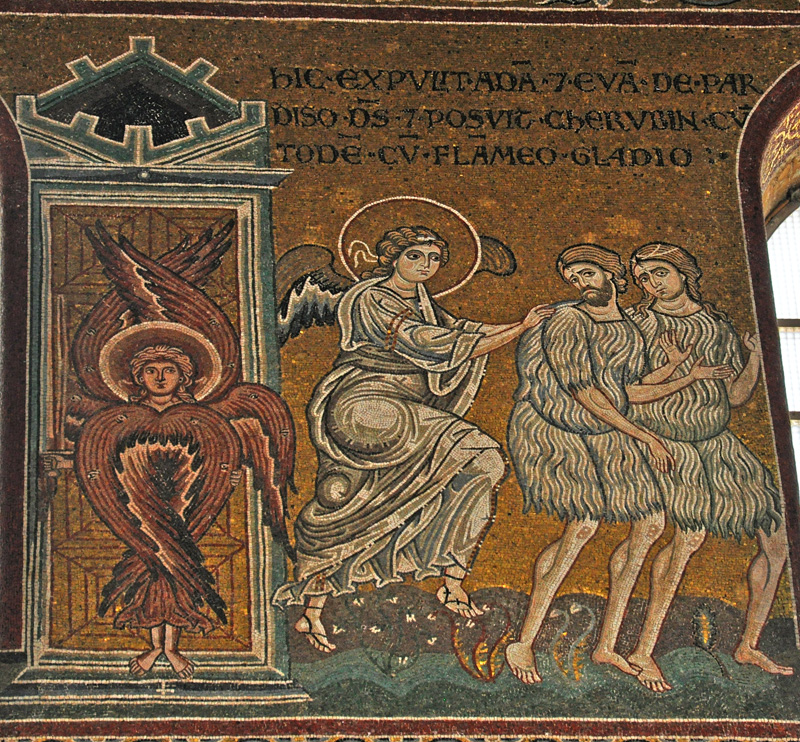THE CREATION OF ADAM AND EVE
In the first account of creation God makes "man" in his image and likeness, "male and female" (Genesis 1:26-31). In the second Adam is created from mud and Eve from Adam's rib (Genesis 2:7, 21-22).The creation of Adam is seen in some Genesis sequences, for example the reliefs on the façade of Orvieto Cathedral and the mosaic sequence at the cathedral in Monreale, Sicily. We see the creation of Eve as early as a 4th-century Roman sarcophagus, where she is created by one of the earliest images of the Trinity. In the sarcophagus relief Eve is already standing by the side of the sleeping Adam, but later works such as the 12th-century mosaics at Monreale Cathedral and Palermo's Palatine Chapel and the reliefs on the 14th-century façade of Orvieto Cathedral all show her emerging from Adam's ribcage or torso.
Eve's creation seems to be a more popular subject than Adam's. In a 13th-century Swiss manuscript page with a medallion for each day of creation, the sixth day has God creating a human who is almost certainly Eve.
In modern illustrations the Creator will often be an old man with a beard (example), but in almost all medieval images he is visualized as the Son, not the Father. The Son, who was to become incarnate as the man Jesus, is the "Word" of John 1:1, "In the beginning was the Word, and Word was with God and the Word was God.… And the Word was made flesh." At least as early as the 2nd century Christian writers extended this to imply that it was the Son who interacted with Adam and Eve in the garden, and the artists followed this cue.1
THE FALL: PALEO-CHRISTIAN IMAGES
In Genesis 3:1-24 the serpent persuades Adam and Eve to eat the fruit of the tree that God had forbidden. This narrative has had a stable iconography from the 4th century into modern times: a tree with fruit, Adam on the left, Eve on the right, and a serpent coiling up the trunk.
One sees the same positive spin in 4th-century images of the curse. In them, God gives Adam and Eve the fruits of their labor: a sheaf for him and a lamb for her (example). The two symbols invoke the traditional tasks of men and women, tilling the earth and spinning thread. Spiritually, they also reference the Eucharist, in which bread becomes the "lamb of God."
The sheaf is also seen sometimes in 4th-century images of Adam and Eve at the tree (example), as if the prospect of the Eucharist were already before them.
THE FALL: MEDIEVAL IMAGES
After the 4th century the sheaf and lamb are mostly forgotten, and the images turn to emphasizing the hardship of the Adam and Eve's new life. Adam will bend over painfully, toiling with his shovel or hoe. example.Otherwise, the medieval tradition follows the pattern established in the 4th century. The couple flank the tree, with Adam usually on the left, and the serpent coils up the trunk. Eve will be variously reaching for the fruit, taking it, and/or passing some to Adam. The two are sometimes shown completely naked when they take the fruit (example), as stated in Genesis 2:24. But most artists either pose them so as to preserve modesty (example) or simply neglect to include the genitalia (example).
Before the Gothic era the serpent was just a generic snake, but in the mid-12th century Peter Comestor wrote that there is a certain species of serpent that has the face of a young girl, and that Satan had chosen to use that kind of serpent to beguile Eve because "like heeds like."3 This claim was repeated by subsequent commentators, the putative species acquired a name ("Draconcopedes"), and by the early 13th century female faces started to appear on the serpent.4 The earliest may be this relief at Amiens. By the 14th and 15th centuries they become quite common (example). The most illustrious example is Michelangelo's panel on the Temptation in the Sistine Chapel.
After they eat the fruit Adam and Eve realize they are naked and make themselves garments of fig leaves. These are almost always represented as single leaves covering the genitals, as in the first picture at right, where we see God confront the couple. The confrontation is less common in the art than the actual expulsion from Eden, in which God "cast out Adam; and placed before the paradise of pleasure Cherubims and a flaming sword turning every way, to keep the way of the tree of life" (Genesis 3:24). The images usually have an angel do the casting out, as in the second picture at right, which also portrays the "garments of skins" (3:21) that God has made for the couple.
ADAM PICTURED AT THE CRUCIFIXION
Medieval and earlier images of the Crucifixion sometimes include Adam in a coffin below the base of the cross (example). This is to remind the viewer that "as in Adam all die, so also in Christ all shall be made alive" (I Corinthians 15:22), a point especially stressed in this manuscript illumination, where Adam holds a chalice to collect the blood falling from Jesus' body on the cross.THE ANASTASIS OR HARROWING OF HELL
In Anastasis or "Harrowing of Hell" images the risen Christ rescues the souls of those who were faithful in the years before the Redemption. Adam and Eve are always the first of these. In western images they may be naked (example); in eastern ones they will be clothed (example).
Prepared in 2014 by Richard Stracke, Emeritus Professor of English, Augusta University.
HOME PAGE

God confronts Adam and Eve after they have eaten the fruit (Mosaic in Monreale Cathedral – see the description page)

Expulsion from Eden. At the gate is the six-winged cherub with the fiery sword. (See description page)
MORE IMAGES
- 4th century (?): Adam and Eve flank the tree in this detail from a sarcophagus lid.
- 325-375: Adam and Eve's expulsion from Paradise is one of the small panels in the Bagawat Exodus Dome Painting.
- Second quarter of the 4th century: the sheaf appears even while Eve contemplates eating the apple in this detail from a sarcophagus in France.
- 340: Adam and Eve are expelled from Eden in very skimpy leather garments in this panel on the "Sarcophagus of Lot."
- Late 4th century: In the center of this fragmentary relief Adam and Eve stand by the tree, while at the right Adam is already hard at work tilling the earth.
- 10th-11th century: Adam and Eve harvest wheat in one of these two ivory panels. But in the other they have taken up ironworking, a less common theme.
- 12th century: The Fall of Man mosaics in the Palatine Chapel, Palermo.
- 13th century: Statues of Adam and Eve flank the entrance to Trogir Cathedral in Croatia.
- 1250-60: Manuscript illuminations on two facing pages in the Wenceslaus Psalter present the Genesis story from the Creation through the murder of Abel.
- Second half of the 13th century: In this manuscript illumination the angel wields his fiery sword as Adam and Eve leave Paradise holding the hoe and distaff emblematic of their punishment.
- 1396: Unusually, this image has the postlapsarian couple in a scene of domestic tranquility.
- 15th century: This relief is a rare example of a medieval image in which the Creator is pictured as an old man with a beard.
- 1440-50: A miniature in a manuscript of Augustine's City of God pictures the serpent with a female face.
- 1689: The story of the Creation and Fall of Man is pictorialized in a subtly choreographed single painting by Cristóbal de Villalpando.
- 1706: A Mexican allegorical painting of Adam and Eve as redeemed humanity.
- Undated: Fragment of a relief with Eve, the serpent, and possibly the lamb.
NAMES
- In the Vulgate Adam is first called by that name at Genesis 2:19. In some modern translations he is simply called "the man."
- In the Hebrew of Genesis 3:20 Adam names the woman Ewwa "because she became the mother of all the living." In Hebrew ewwa relates to the word for "life," so Greek translations call her ΖΩΗ, "life." But for the Vulgate Jerome transliterated Ewwa to Latin Eva (pronounced "Ewa"). From that came the name familiar to English speakers, "Eve."
MEDIEVAL LORE
- Caxton's "Life of Adam" covers much of the medieval thinking on the interpretation of Genesis.
ALSO SEE
NOTES
1 See for example, Theophilus to Autolycus: "The God and Father, indeed, of all cannot be contained, and is not found in a place, for there is no place of his rest; but His Word, through whom He made all things, being His power and His wisdom, assuming the person of the Father and Lord of all, went to the garden in the person of God, and conversed with Adam" (II, xxii, p. 103).
2 Augustine, De Genesi contra Manichaeos, II, xx (Pat. Lat. XXXIV, 211-212). Bede, In Pentateuchum Commentarii, II, iii (Pat. Lat. XCI, 215). Also see Glossa Ordinaria, I, 102-103).
3 Elegit etiam quoddam genus serpentis, ut ait Beda, virgineum vultum habens, quia similia similibus applaudunt…, "[Satan] chose a certain kind of serpent, as Bede says, that has a young girl's face, because like heeds like," Historia Scholastica, Genesis chapter 21 (Migne 198, col. 1072). But Bonnell (257) found no such statement either in Bede or in works spuriously attributed to him. Laderman (8) traces the idea to the 5th-century rabbinical Bereshit Rabbah, but that work merely puns that Eve (Havah) was the hivya ("serpent" or "seducer") of Adam. … As for feminist interpretations of this iconography one should apply Ockham's razor. The simplest explanation for Peter's saying "like favors like" is that a woman is in fact more likely to heed the advice of another woman than that of a talking snake. And the simplest explanation for a medieval artist's giving the serpent a woman's face is that a highly respected exegete has said it had one.
4 The "Draconcopede" is in Vincent of Beauvais's Speculum Naturale, XX, xxxiii (Bonnell, 258). For a survey of other commentaries, images, and plays featuring a woman's face on the serpent, see Bonnell, 258-88.